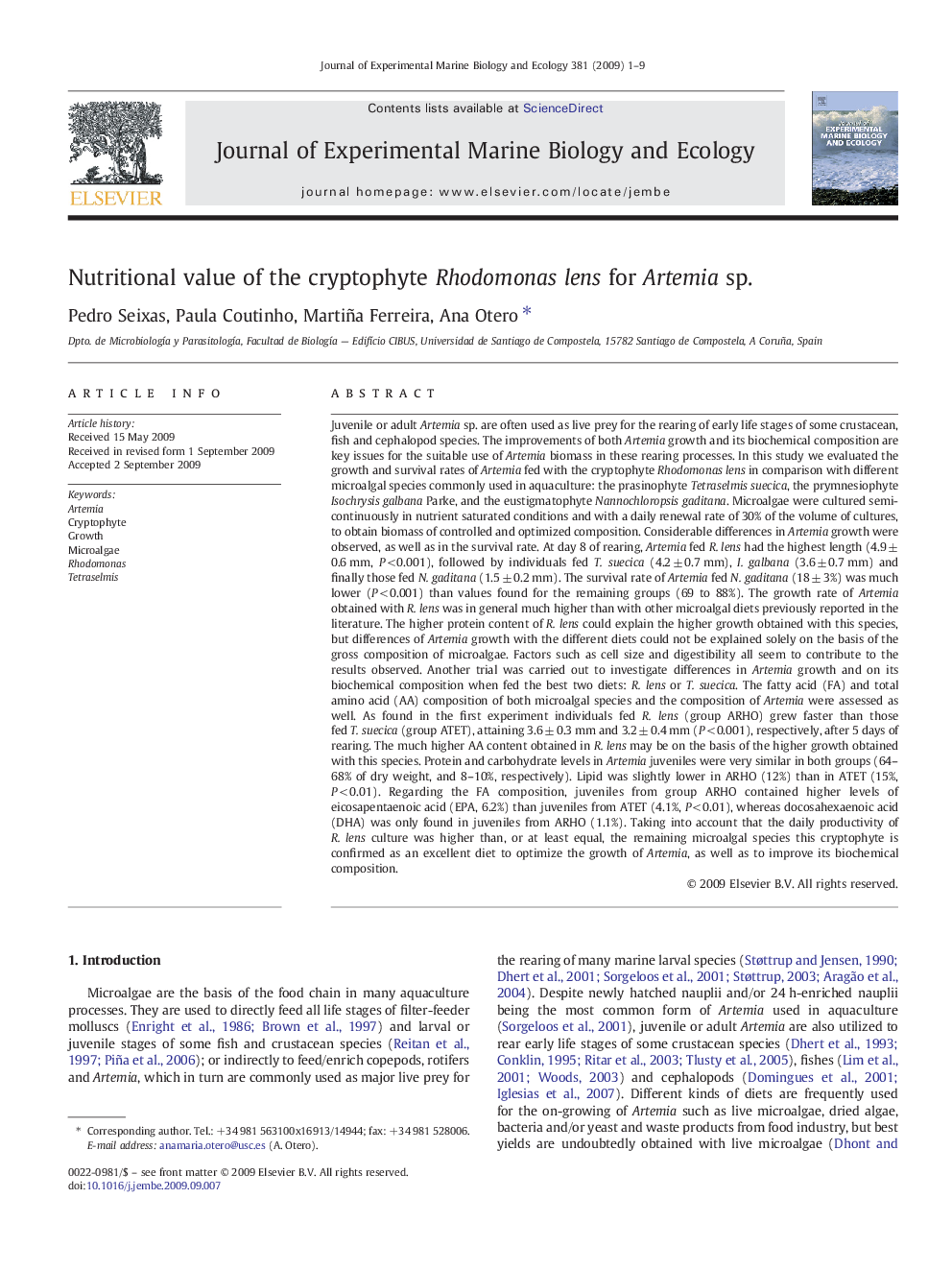| کد مقاله | کد نشریه | سال انتشار | مقاله انگلیسی | نسخه تمام متن |
|---|---|---|---|---|
| 4396685 | 1305836 | 2009 | 9 صفحه PDF | دانلود رایگان |

Juvenile or adult Artemia sp. are often used as live prey for the rearing of early life stages of some crustacean, fish and cephalopod species. The improvements of both Artemia growth and its biochemical composition are key issues for the suitable use of Artemia biomass in these rearing processes. In this study we evaluated the growth and survival rates of Artemia fed with the cryptophyte Rhodomonas lens in comparison with different microalgal species commonly used in aquaculture: the prasinophyte Tetraselmis suecica, the prymnesiophyte Isochrysis galbana Parke, and the eustigmatophyte Nannochloropsis gaditana. Microalgae were cultured semi-continuously in nutrient saturated conditions and with a daily renewal rate of 30% of the volume of cultures, to obtain biomass of controlled and optimized composition. Considerable differences in Artemia growth were observed, as well as in the survival rate. At day 8 of rearing, Artemia fed R. lens had the highest length (4.9 ±0.6 mm, P < 0.001), followed by individuals fed T. suecica (4.2 ± 0.7 mm), I. galbana (3.6 ± 0.7 mm) and finally those fed N. gaditana (1.5 ± 0.2 mm). The survival rate of Artemia fed N. gaditana (18 ± 3%) was much lower (P < 0.001) than values found for the remaining groups (69 to 88%). The growth rate of Artemia obtained with R. lens was in general much higher than with other microalgal diets previously reported in the literature. The higher protein content of R. lens could explain the higher growth obtained with this species, but differences of Artemia growth with the different diets could not be explained solely on the basis of the gross composition of microalgae. Factors such as cell size and digestibility all seem to contribute to the results observed. Another trial was carried out to investigate differences in Artemia growth and on its biochemical composition when fed the best two diets: R. lens or T. suecica. The fatty acid (FA) and total amino acid (AA) composition of both microalgal species and the composition of Artemia were assessed as well. As found in the first experiment individuals fed R. lens (group ARHO) grew faster than those fed T. suecica (group ATET), attaining 3.6 ± 0.3 mm and 3.2 ± 0.4 mm (P < 0.001), respectively, after 5 days of rearing. The much higher AA content obtained in R. lens may be on the basis of the higher growth obtained with this species. Protein and carbohydrate levels in Artemia juveniles were very similar in both groups (64–68% of dry weight, and 8–10%, respectively). Lipid was slightly lower in ARHO (12%) than in ATET (15%, P < 0.01). Regarding the FA composition, juveniles from group ARHO contained higher levels of eicosapentaenoic acid (EPA, 6.2%) than juveniles from ATET (4.1%, P < 0.01), whereas docosahexaenoic acid (DHA) was only found in juveniles from ARHO (1.1%). Taking into account that the daily productivity of R. lens culture was higher than, or at least equal, the remaining microalgal species this cryptophyte is confirmed as an excellent diet to optimize the growth of Artemia, as well as to improve its biochemical composition.
Journal: Journal of Experimental Marine Biology and Ecology - Volume 381, Issue 1, 30 November 2009, Pages 1–9